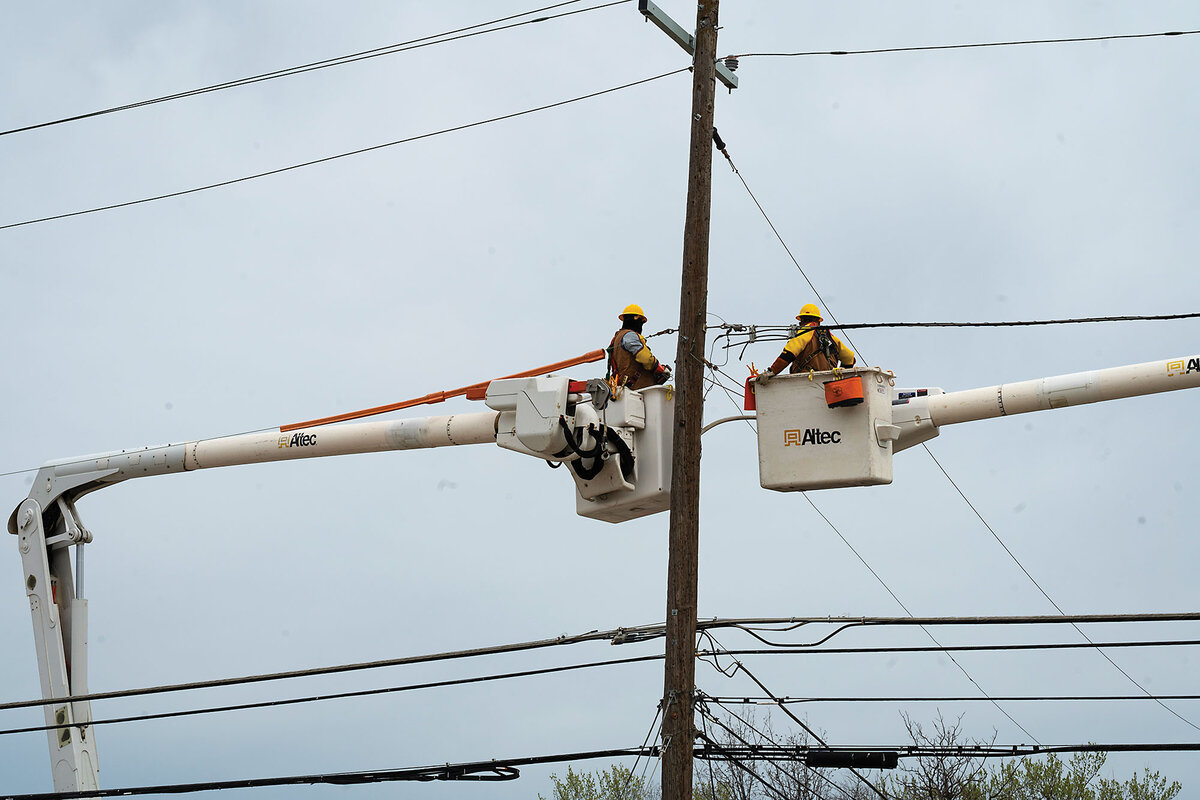Do you really know how the US power grid works? You should. Here’s why.
Loading...
You’ve probably heard references to “the grid.” Every week, it seems, there is news from somewhere around the United States about the power grid’s reliability – or lack thereof.
We read about its stress under heat waves and its vulnerability to cold spells. Congress holds hearings about its resilience and whether it can adapt to a world of clean energy. News articles discuss the ‚Äúsmart grid‚Äù and the ‚Äúflexible grid‚Äù and what a ‚Äúnext-generation grid‚Äù might entail. We hear messages about how ‚Äúelectrify everything‚Äù is the climate priority, but we also get warnings that electricity demand is already pushing the grid to the breaking point.¬Ý
And then there are electric bills. According to the U.S. Energy Information Administration, in 2022, the average residential bill over 2021, well above overall inflation. For the most recent 12 months (ending in June), the pace is slower, but electricity costs have jumped another 4.4%, according to the Bureau of Labor Statistics.
Why We Wrote This
News about “the grid” and warnings about its vulnerability are ubiquitous. We break down what the grid is and why it’s so complicated to fix.
One explanation: Utilities needed extra money to pay for the grid.
What, actually, is the grid?¬Ý¬Ý
The easy answer is that it is our fundamental power infrastructure, which supplies electricity for everything from household lights and refrigerators to the internet, data centers, and hospitals. But go deeper, and one ends up quickly in a jumble of regulatory authorities, utilities, wires, power plants, early-20th-century technologies, and cutting-edge science – as well as big questions about what power and life should look like in the 21st century.
To start, it‚Äôs important to remember that what we call ‚Äúthe grid‚Äù is a physical thing, sometimes called ‚Äúthe largest machine in the world.‚Äù And the first part of this machine‚Äôs operation is power generation. This might be a coal power plant, or a big solar array. Power generators capture energy in some way ‚Äì from the sun or wind or fossil fuels or rushing rivers ‚Äì and turn it into electricity.¬Ý
This electricity then travels over transmission lines. These cables carry high-voltage electricity over long distances from the power generators to local substations. Substations, then, convert this high-voltage electricity to a lower voltage that can be used by homeowners and businesses. That lower-voltage electricity travels across distribution lines to the end user.¬Ý
What’s so complicated about the grid?
The thing is, there‚Äôs not really just one grid in the U.S. Broadly speaking, there are three systems of power generation, transmission, and distribution ‚Äì one in the East, one in the West, and one in Texas. And within those three systems, there are local grid operators. These are typically the utilities, which can either be set up as private companies or customer-owned cooperatives.¬Ý
The grid operators’ job is to make sure the grid is balanced – to ensure not only that there is enough electricity going to where it is needed, but also that there isn’t excess electricity flowing through cables. Remember, we’re talking about physical objects here. If wires are overloaded with electricity that doesn’t have a home, a bunch of things can go wrong, from tripped circuits to overheated cables and fire risk.
That means not only minute-by-minute adjustments are required, but also long-term maintenance, planning, and build-out of all those electric lines and substations. In some places, there are regional groups that help strategize and coordinate the grid operators ‚Äì and, in some areas, allow for wholesale energy suppliers, which can take the form of private companies competing to sell consumers their electricity. (The regional utilities generally still manage and deliver that electricity.) It gets complicated, but the takeaway here is that the three big U.S. grids could be seen as a collection of lots of little grids, all with different management structures, power sources, goals, and profit incentives.¬Ý¬Ý
“It’s not uniform across the country,” says Jennifer Chen, senior manager for clean energy at the World Resources Institute. “Different regions have different systems.”
And that, say grid experts, is increasingly a problem – especially as extreme weather creates regional spikes in electricity demand.
“The grid is not large enough. And because it’s not large enough, and because the different regions of the country are not as well connected together as they should be, the grid isn’t as resilient as it should be, and therefore our health and economy is at risk,” says John Moore, an energy expert at the Natural Resources Defense Council.
That doesn‚Äôt mean that we don‚Äôt have enough power in our country. To the contrary, says Mr. Moore, we have enough power to fuel our needs, whether that‚Äôs for increased use of air conditioning in a heat wave or for a data center. The trick is getting it from point A to point B.¬Ý
Doing this becomes increasingly complicated as energy generation shifts from fossil fuel-based power plants to clean-energy sources such as wind and solar power, which tend to be located farther away from population centers. It also gets more complex as demand for power increases because of factors such as the growing digital economy and the rising number of electric vehicles.¬Ý
How do we fix the problems with the grid?
To carry electricity over longer distances, we need more transmission lines, Mr. Moore says. Indeed, he says, studies have shown that if the country had enough lines, we could have a reliable, nearly carbon-free electric system by 2035.
Ms. Chen says we should also think more strategically about where we locate industries that consume large amounts of electricity. It might make more sense to locate a data center, for instance, in the wind-rich Great Plains, where there is often so much wind energy that the grid can’t even absorb it, than in northern Virginia, the current hub of U.S. data centers.
We can also increase the efficiency of our existing system, Ms. Chen says. In many places, grid infrastructure is almost a century old. New wire technology, for instance, would allow for more electricity to travel much farther distances along existing lines.¬Ý¬Ý
But at the moment, experts say, there is less financial incentive for utilities to upgrade and maintain lines than to take on expensive new capital projects and build out new infrastructure. That’s a policy and structural issue many grid experts think must change.
Overall, Mr. Moore says, the grid of the future will have to become even more connected and integrated. It will have to be larger than the systems that generate power, like solar and wind, so that if there are clouds in one area, sunshine elsewhere can still help keep the lights on. That also means that if one region is seeing a spike in demand because of, say, a heat wave or storm, areas with more moderate weather and lower demand could pass along their extra electricity.¬Ý¬Ý
But there are big grid updating . This summer, the U.S. Department of Energy announced it would spend $2.2 billion on eight grid projects across 18 states, part of the 2021 Bipartisan Infrastructure Law’s grid resilience and innovation partnerships program. That includes funding for new, large transmission lines; technology to improve the connection between the eastern and western grids; and infrastructure to bring the power from wind farms off the coast of New England into Massachusetts and Connecticut.
“The first half of 2024 has already broken records for the hottest days in Earth’s history,” said Energy Secretary Jennifer Granholm in a press release. “As extreme weather continues to hit every part of the country, we must act with urgency to strengthen our aging grid to protect American communities.”





